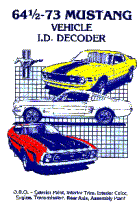|
 IMPORTANT INFORMATION ON IDENTIFICATION LABELS OR
PLATES IMPORTANT INFORMATION ON IDENTIFICATION LABELS OR
PLATES
Over the past years Ford has offered a multitude of models,
a wide choice of optional equipment, and hundreds of power-train
options. And, it has been said that Ford could run its production
lines for a complete year and never build the exact same model twice
(interior / exterior color, trim, comfort and convenience accessories, ect.). This statement seems highly reasonable when you dig into all
the possible combinations that are available.
Your ability to "read and understand" either the Vehicle
Identification Number (VIN) Plate or the Safety Standard
Certification Label plays an important role in servicing these
models.
This Knowledge is vital when you are called upon to maintain
the vehicle and its emission control systems. Being able to
"interpret" the code system Ford used in prior years will help you to
eliminate lost time, avoid confusion, and prevent ordering incorrect
parts or components.
LOCATION OF CAR IDENTIFICATION
LABELS AND METAL PLATES
The Safety Standard Certification Label for
Ford-built passenger cars is located either on the Lock Face of the
Left Door or the Door Pillar.
READING THE D.S.O. (SPECIAL
EQUIPMENT) CODES.
Many vehicles such as police
cars, taxis and special order trucks have customer requested equipment
installed at the factory, and are identified by a Domestic Special
Order code (D.S.O.)
D.S.O. codes have been stamped into truck plates since 1957
and passenger cars since 1962. In addition, all vehicles delivered
since January 1962 with special equipment, have a blue envelope in the
glove box containing a copy of the Special Equipment Parts List used
on that particular vehicle. The selling dealer also has a yellow copy.
A typical D.S.O. number might be 13-0645. In breaking this
number down, the (13) indicates the District (in this example, New
York) in which the vehicle was delivered. The (0645) indicates it was
he 645th vehicle with special equipment delivered for that year. On
some plates you may find a D.S.O. number such as (13-) without a
second series of numbers. That is NOT a vehicle with special
equipment. The number (13), for example, refers only to the District
(New York) in which the vehicle was delivered.
To order special equipment parts for vehicles delivered
after January 1962, simply use the D.S.O. parts list in the glove box.
If this list is not available then use the D.S.O. code on the Rating
Plate or the Certification Label. If neither is available, give your
Ford or Lincoln-Mercury Parts Manager any information stamped or
stenciled on the part you need. He, in turn, can then deliver the
correct part you request.
OFFICIAL
VEHICLE IDENTIFICATION NUMBER-OF05M130122
The official Vehicle Identification
Number (VIN) for title registration purposes is stamped on an aluminum
tab that is riveted to the instrument panel close to the windshield on
the drivers side of the car and is visible from outside. The first
number indicates the model year. The letter following indicates the
assembly plant from witch the car was made. The next two numbers
designate the body style followed by the letter code for the engine.
The last six numbers of the VIN. are the consecutive unit numbers for
that model car.
VIN NUMBER
0F05M130122
-
*100001 - Ford
-
Fairlane
-
Falcon
-
Mustang
-
Thunderbird
-
Maverick
|
|
|
|
VEHICLE CERTIFICATION LABEL
The
Vehicle Certification Label is attached to the rear face of the
driver's door. The upper half of the label contains the name of the
manufacture, the month and year of manufacture and the certification
statement. On this label you will find the Vehicle Identification
Number (VIN.) This number is also used for warranty identification
of the vehicle.

The first number
indicates the model year. The letter following the model year number
indicates the manufacturing assembly plant. The next two numbers
designates the Body Serial Code followed by a letter expressing the
Engine Code. The last six numbers of the Vehicle Identification
Number indicate the Consecutive Unit Number.
The
remaining information on the V.C. Label consists of pertinent
identification codes. The Body code is two numbers and a letter
identifying the body style. The COL. code is a number or letter (or
both) indicating the exterior paint color code. The Trim code consists
of a number-letter combination designating the interior trim. The Axle
code is a number or letter indicating the rear axle ratio and standard
or locking type axles. The Trans code is a number or letter indicating
the type of transmission. The D.S.O. code consisting of two numbers
designates the district in which the car was ordered and may appear in
conjunction with a Domestic Special Order or Foreign Special Order
Number when applicable. Ford of Canada D.S.O. codes consist of a
letter and a number except for export codes which are designated by
two numbers.
|
|
![]()
![]() 01/31/05
01/31/05